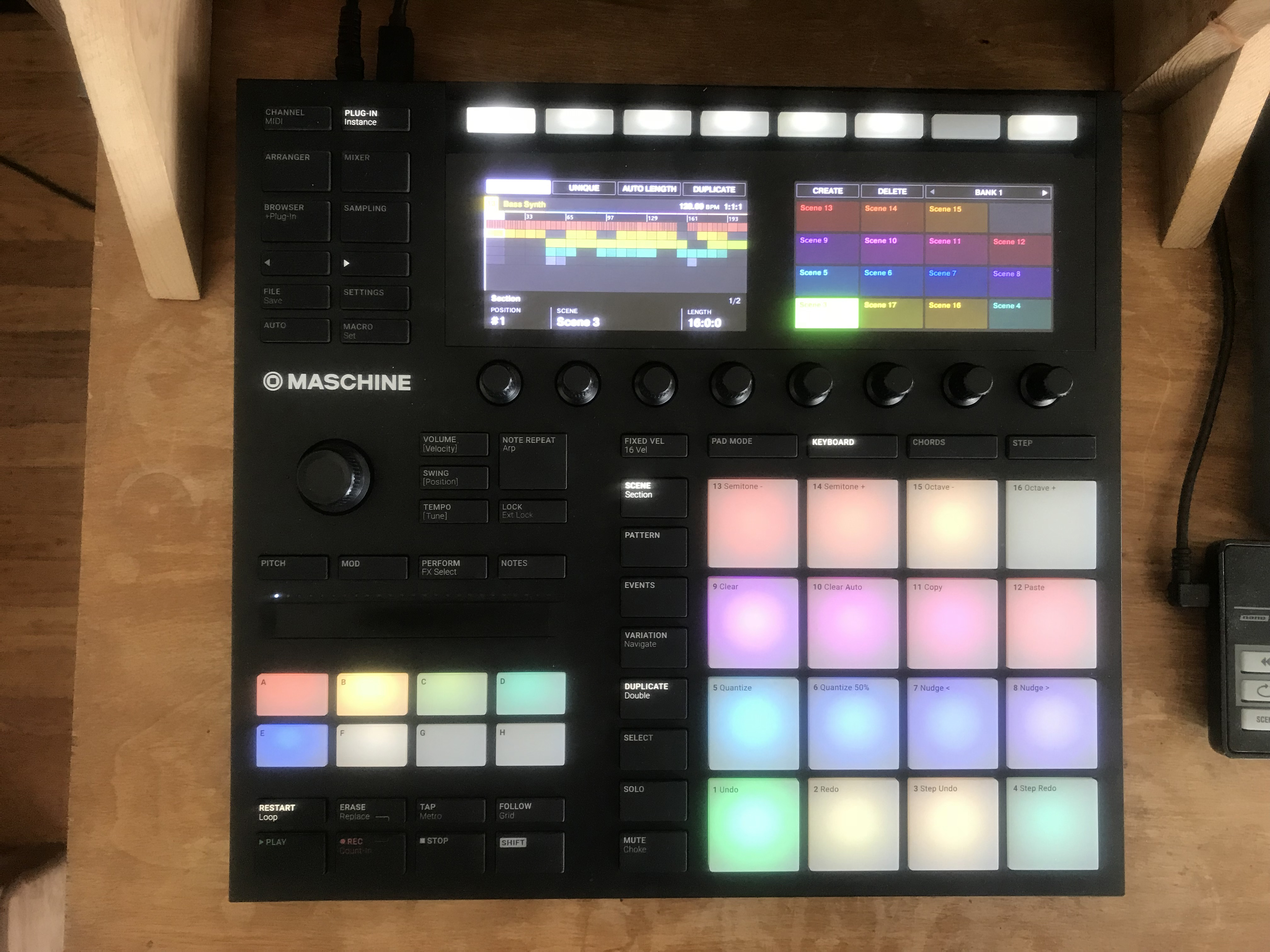
Introduction
The Native Instruments Maschine MK3 is a DAW-tethered MIDI controller with 16 velocity sensitive pads (& aftertouch?), 8 touch-sensitive knobs, one select knob, two color LCD screens and several onboard button controls. These all link up with a software application that contains it’s own DAW, specifically for the Maschine “instrument” or ecosystem. The app can also operate as a plug-in on software instrument tracks in popular DAWs like Apple’s Logic Pro or Ableton Live.
First, I “only” have the MK3 not the +, so my review will be on the shared feature set. Also, this is in my studio on loan from fellow Trilobyter & studio pal, Scottino – thanks dude!
Pros
- Ability to load many groups of 16 samples
- Nice color screens
- Great pads, biggest & very sensitive (adjustable)
- Perform FX strip
- Morph synced fades between parameter states
Cons
- Only one stereo input
- Only one stereo output
- Not touchscreens
- MK3 is tethered to the computer (+ is standalone)
Also, because its tethered to a DAW, whether its own or another and I’ve been more working on outboard composition and sampling, I’m using this less than my other gear. That said if i need a DAW controller, it does work in some limited form. Using Ableton 10+, I an use my Akai Force, too.
I did just create my first full 16-section project with 5 groups of sounds. In fact I’m probably going to be using that for some game audio I’m working on for Exo. So, it has come in handy. Also, I like the ability to chain sections together into a longer playback cycle. The morph feature is sweet too. Also, the perform effects. Not to mention the sounds.
Sounds, Synths & FX
The sequencing potential is expansive. I definitely need to learn it better. But, Native Instruments’ sounds, synth and FX options are excellent. Really top notch. The pads themselves are great. The knobs, being touch-sensitive, are also very nice and responsive (provided they don’t get dusty, at which point they can jump around uncontrollably). The screens should be touch sensitive. After using my Force and iPads, I keep using my fingers to try to control parameters on the Maschine, so it’s a bit of a cognitive leap between interfaces. But at least there are screens and they do display useful information.
I think Native Instruments, and Maschine in general, or maybe just the latest libraries from them, are known to have good – no really good sounds. This continues here. The software instruments are great, although the corresponding display could be better.
Screens
For example, the Force shows the actual plugin with knobs and the UI. Also, it maps the 8 knobs to various sets of modulation options. I really wish the Maschine did something similar with its screens. Currently they’re not very useful, except where the numerical values (and parameter labels) display above the knobs. They could be much better used in this case. However, I do like the visibility and name-ability of the pads and corresponding bits on the screen, which is great.
Conclusion
Overall, the Native Instruments Maschine MK3 is a very capable unit—when used with a computer. I would imagine the + is just extra. I mean, it’s kind of what I would want from it. Maybe a few more inputs, but otherwise looks really nice, with the metal chassis, too. But, especially the ability to work standalone (ie, apart from a DAW or computer). The pads are some of the nicest and most sensitive I’ve ever used. The Morph feature is super creative and cool (morphing between two sets of parameters over a set length of time). Also the touch-strip effects are especially cool for adding a bit of turntable-esque control to your patterns. The event editor is a bit tedious, but the scenes and sections (?) are nice and expansive. Also having 8+ groups to work with at any given moment is nice.
Working without a computer makes any kind of labeling and detailed event editing extremely tedious. And some functions I haven’t figured out via hardware only yet (assuming it’s possible to use the hardware to do anything the software can do?)
I like the fact that it will “automap” to Ableton Live and I can use it as a MIDI controller for Live straight away. Now i can use endless rotaries for volumes (maybe not in the most optimized format, but…) and switch between some modes of control. It’s still quite limited compared to an Akai APC40 or something more customized for Ableton. But, it’s something.
What do you think? Want to see how it compares to other grooveboxes that I currently own? Read my full Groovebox Showdown post here.
